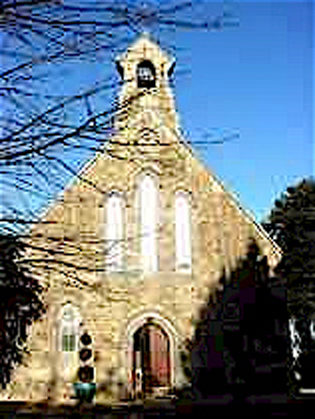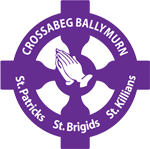
Crossabeg Church
The present Parish of Crossabeg comprises the older Parishes of Artramont, Kilpatrick and Tykillen.
The present Parish of Crossabeg comprises the older Parishes of Artramont, Kilpatrick and Tykillen. Artramont was dedicated to St. Brigid, the ruins of the church can still be seen along with the graveyard in Artramont and St. Brigid's Well is a short distance away. Kilpatrick (Cill Phadraig) as the name indicates, was dedicated to St. Patrick, and was appropriated in the 13th century to the priory of Glascarraig. The ruins can still be seen in the demesne of Saunderscourt. The Romanesque doorway once belonged to the church of St. David at Ballinaslaney in the present Parish of Oylegate. Fr. Redmond Roche, P.P. of Crossabeg 1789-1819 is buried in this graveyard and St. Patrick's well is located in the adjacent field. Tykillen (Tigh Cilian) was named after St. Killian - Irish Bishop and martyr. Only a few overgrown stones mark the outline of St. Killian's Church in the centre of the now closed graveyard. St. Killian's well is located five miles away on the road from Crossabeg to Ballymurn. St. Killian's feast day is celebrated on July 8th and this is traditionally associated with Patron day in Crossabeg with Masses and prayers being said in the graveyards on the Sunday nearest July the 8th. In more recent times the Patron day was fixed for the first Sunday in July but, since 2002 has been held on the first Saturday in July with Mass at 7.00pm. This change was necessitated by the change in the G.A.A. calendar which has fixed the Leinster Senior hurling final in Croke Park for the first Sunday in July. The old church in Crossabeg was built in 1765, but was burned in the aftermath of the 1798 rebellion on 24th June, 1799. It was rebuilt in 1803 and remained in use until the new (present) church was opened in 1914. The site of this church is marked by the Calvary in the lower section of the present graveyard in Sion, Crossabeg which was erected and blest in 1934 following the demolition of the old (Fr. Dixon's) Parochial House. The foundation stone for the new church was blest and laid by the Bishop Most Rev. Dr. Browne on August 25th 1912 along with a sealed bottle containing newspapers and coins of the period together with a record of the ceremony inscribed on parchment in both Latin and Irish: "For the Glory of God. James, Bishop of Ferns in the 28th year of his rule, for the greater glory of God and the good of religion, laid the Foundation stone of the Roman Catholic Church of Crossabeg and placed it under the patronage of Saints Patrick, Brigid and Killian." Thus the old medieval parishes of Kilpatrick (Saunderscourt), St. Brigid (Artramont) and St. Killian (Tykillen) were united. The new church was completed and opened on Sunday, August 2nd 1914. The total cost was £6,244.00 including all furnishings, stained glass windows etc. The woodwork was executed by Mr. J. Shipley of Blackwater, a master craftsman. The church is a handsome Gothic - style stone building with granite quoins and limestone dressings. There is a small window at each side of the main door and a belfry surmounts the entrance gable. Over the entrance are three lancet windows lighting the choir gallery.
Six similar windows are on the right-hand side of the church and five on the left-hand side which has a side porch (now used for wheel-chair access). Over the high altar are three lancet stained-glass windows by Meyer of Munich depicting two of the church patrons St. Patrick and St. Brigid and in the centre the Sacred Heart. At the left-hand side of the sanctuary two similar windows depict the third Patron - St. Killian, and St. Aidan- the Patron Saint of the Diocese of Ferns. The invocations are in Irish and decorated with Celtic motifs. Beside the High Altar are statues of St. Gerard Majella and St. Benedict, while side altars at the edge of the sanctuary are devoted to Our Lady and St. Joseph. The boundary wall which is built in the same style as the church complements the main building. It is constructed of rough sandstone and the three entrances have wrought-iron gates with piers of dressed limestone. The grounds which are regarded as one of the most beautiful in the Diocese were laid out in 1915. The Harvey and Walker families came to the aid of the Parish. They provided their own private gardeners - William Roche and Matthew Murphy - to do the work. It is planted with ornamental trees and flowering shrubs providing bloom from March through to November each year. During the period 1869 -1970 Ballymurn became the "Parish" church. In 1869 the then curate at Ballymurn Fr. Edmund Doyle (CC from 1858) was promoted Parish Priest but elected to stay in Ballymurn with the new curate moving to Crossabeg. This custom was continued until January 1970 when the very Rev. William Grattan- Flood PP, Templetown, was transferred to Crossabeg following the death of Very Rev. James Canon Murphy, PP and the transfer of the resident curate - Fr. Seamus O'Byrne - to Wexford. With both positions being vacant Fr. Grattan-Flood chose Crossabeg. "It was time to restore the old order" Fr. Grattan-Flood a noted church historian and son of Chevalier W. H. Grattan-Flood, author of the history of the diocese of Ferns, said upon his arrival in the Parish! In the priest's burial plot located within the church grounds can be seen the grave and monument to Fr. James Dixon (1758-1840) the famous "Convict Priest". Fr. Dixon, a native of Castlebridge, was appointed CC Crossabeg to assist Fr. Redmond Roche, PP in 1794. Fr. Dixon was transported to Australia following the 1798 rebellion, arriving there in January 1800 and became the first Prefect Apostolic appointed by the Holy See to Australia. On his return home Fr. Dixon was reappointed as curate to Crossabeg in 1811 becoming PP in 1819 where he remained until his death in 1840.
Come Visit Us
Crossabeg Church, Ballyshane, Co. Wexford
info@crossabegballymurnchurch.ie
PHONE
+353 53 9138103
SOCIAL
